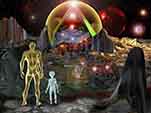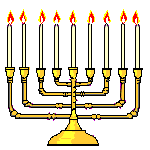What follows was written by me as a result of my erroneous reading of a Rumills Onelist email:
(Message: 1
Date: Sun, 2 Jan 2000 17:50:05 EST
From: RuMills@xxx.xxx
Subject: Iran calls for Israel to be 'destroyed'
-- A Call for Armageddon?)
I misinterpreted Rayelan's Austrian Templar source as having stated that the Jewish Diaspora resulted from an (to the best of my knowledge) undocumented Roman bounty to be paid for the killing of Jews of the Davidic line. Yesterday I reread the Onelist message and understanding struck me.
Perhaps the following information will be of interest to someone.
Pax
vM
Throughout this post I tend to rely heavily on Schurer’s A History of the Jewish People in the Time of Jesus Christ because I am delighted with it and because I received a copy of the History as a Christmas gift. I also make much use of the Mercer Dictionary of the Bible. Edited by Watson E. Mills, it represents some of the best Southern Baptist scholarship from a time when Southern Baptists were interested in and capable of producing genuine scholarship.
I
Apocalypse
A literature of distress, works apocalyptic are found both within and without the canon of Holy Writ. Within the canon it is found in both Old and New Testaments. Old Testament examples include parts of Daniel, Ezekiel, and, most notably, some of the Minor Prophets. New Testament examples include discourses by Jesus in the Synoptic Gospels (Matthew, Mark, Luke) that begin with a discussion of the eventual destruction of the Temple. Further New Testament examples may be found in the Pauline literature in the First and Second letters to the Thessalonians, and the Johanine Revelation.
Some modern popular Christian sociological works may also represent a further development of the genre. Such an example may be found in Culture Wars, the Struggle to Define America written by James Davison Hunter. (The full bibliographical particulars are: Hunter, James Davison. Culture Wars, The Struggle to Define America. New York: Basic Books, A Division of Harper Collins Publishers, Inc., 1991.) Hunter’s work may be an intellectualized writ of distress.
While studying Theology in Louisville, Kentucky, I had the great good fortune to have as a professor one Dr. Harold Songer. I find in my notes from his Advanced Introduction to the New Testament the following:
Theodicy (the problem of the presence of evil) may lead to apocalypse - a literature of distress. Also that the assumptions inherent in apocalyptic thought include the division of history into segments which degenerate through time and that human existence is marked by terrible conflict. That conflict is so extreme as to require severe, direct heavenly intervention. The characteristics of apocalyptic literature are listed in my notes as: 1. History written as prophecy 2. Authorship is associated with some ancient worthy 3. Writers in the apocalyptic genre usually misinterpret their present 4. Visions are literary vehicles 5. There is evidenced a reliance upon theriomorphic symbolism 6. There is evidenced a reuse of old or a redeployment of accepted, easily recognized symbols from the ambient culture
On a personal note, I believe that much of our own (certainly my own) conspiracy theorizing may be characterized as a literature of distress.
II
Messianic Expectation
A discussion of Jewish apocalyptic literature and its elements leads reasonably to a discussion of Jewish Messianic expectation and its elements. In discussing the literature, one tends to see one as a subset of the other, although it is better than arguable that the canon of Scripture is shot through with a Messianic expectation.
As regards eschatalogical conspiracies, this discussion of Jewish Messianic expectation is important if there truly is some conspiracy rooted in historic Judaism that intends to bring about an Armageddon event. It is important because the Jews do not believe that Jesus Christ fulfilled that Messianic hope long cherished by their people. Any Jewish conspirators, therefore, may be expected to act in accordance with their own and not Christian eschatology. Schurer’s work tells us what that eschatology was at about the time of Christ and we may be able from there to trace its further development.
In the Old Testament, orthodox Christian interpretation notes messianic indicators as early as Genesis 3:15 - the seed of the woman who will crush the serpent’s head. Moses, somewhere in the Pentateuch (Deut. 28:15), says that another like him will come and will likewise deliver the Israelites (the structure of Matthew’s gospel may indicate a conscious attempt to portray Jesus as that one like Moses - it is also interesting to note that John’s gospel refers to those opposing Jesus as the Jews - a possible implication is that those children of Abraham who were/are disciples of Christ are Israelites). Malachi states explicitly that Elijah will come before the Messiah, turning the hearts of fathers to their sons and the hearts of sons to their fathers. There is also a great deal of extra-canonical material from the inter-testamental period (what Christian theologians call the period roughly from the writing Malachi to the birth of Christ).
I rely on Schurer’s work for my information about the elements of Jewish Messianic expectation, and Schurer relies to a large extent on those intertestamental works to prove that Messianic expectation was present in the awareness of the Jewish people in Palestine and elsewhere at the time of Jesus Christ. (Schurer, Emil. A History of the Jewish People in the Time of Jesus Christ. Division II. Vol. II. New York: Hendrickson Publishers, Inc. 1998. Reprinted from the edition originally published by T. & T. Clark: Edinburgh, 1890.)
Schurer supplements his previous historical survey by providing a “systematic statement of Messianic doctrinal theology...(154)” He lists and expounds upon the various elements he finds in his sources, mentioning also the work and conclusions of other scholars.
1. The last tribulation and perplexity - Schurer notes that regarding last things a recurring theme is that “the appearance of redemption must be preceded by a period of special trouble and affliction...the travail of the Messiah, which must precede His birth...announced by omens of all kinds. The sun and moon ...darkened, trains of horse and foot march through the clouds... sun appears by night, the moon by day. Blood trickles from wood, the stone gives forth a voice, etc. (154,5)”
2. Elijah as the forerunner
3. The appearing of the Messiah - “Most frequently called the Anointed, the Messiah,...He is called the Elect...the Son of God...Son of the Woman...universally acknowledged...He would proceed from the race of David...Hence, Son of David is a usual title (159).” The original expectations of Messiah developed through time - “The original Messianic hope did not expect an individual Messiah at all, but theocratic kings of the house of David. Subsequently the hope was consolidated and raised more and more into the expectation of a personal Messiah as a ruler endowed by God with special gifts and powers (159-60).” After a fairly lengthy discussion of the latter rabbi’s “ingenious computations (163)” as to the time of Messiah’s appearing, the author concludes with the general consensus that “the Messiah cannot come until the people repent and perfectly fulfill the law. If all Israel would together repent for a whole day, the redemption by Messiah would ensue. If Israel would only keep two Sabbaths properly, we (?) should be immediately redeemed (163).” There is a final interesting note about the Messiah (163,4) as to his expected instant manifestation: “all at once he is there and appears as a victorious ruler. As on the other hand it is assumed, that he is born as a child in Bethlehem, the two views are combined by the admission that he will at first live in concealment and then suddenly come forth from concealment.”
This particular element is of great interest to the end-times conspiracy theorist. Philip, in one of his posts on the Rumormill News Forum discusses the possibility of a Second Christ. He asks whether the unborn child of the late Princess Diana was intended by the prophecy fakers of the New World Order conspiracy to become that Second Christ.
Such an arrangement, based upon the information derived from Schurer’s work, would eminently suit Judaic conspirators, and would certainly fool even most culturally Christian people. Knowledge that the canon of the New Testament clearly indicates that God became man in Christ Jesus, lived, died, rose again as the physically embodied God/Man, ascended into heaven, and sits at the right hand of God the Father is completely outside the awareness of most people. Jesus Christ never ‘disembodied’ upon His ascension. Therefore at the Second Coming, the SAME JESUS who ascended will return. Most people assume that Jesus will undergo the process of reincarnation prior to the Second Coming. That concept is totally incompatible with the biblical record, but the reincarnation idea will tend to facilitate general acceptance of the Anti-Christ, who will probably be accepted by Jews as their Messiah.
For these reasons, if the Diana theorists are correct and the child she was carrying was intended (by the prophecy fakers of the NWO conspiracy) to serve as a pseudo-christ/second Jesus/antichrist then some speculative conclusions may reasonably be drawn. They are:
1) There is some splinter group within the NWO proper that hoped to delay the faked fulfillment of Jewish Messianic hope/one world government;
2) If Diana was carrying a child, the fetus was a) preserved in some sort of stasis to be reanimated and developed (yes, filmlike) at a more appropriate time; b) kept for future cloning; c) totally destroyed - burnt to cinders;
3) we can expect to hear of further developments regarding this child of Diana as we progress through time and events unfold.
4. Last attack of the hostile powers - There ensues discussion of the expectation that the goyim (sp?) will come against the newly revealed Messiah in an attempt to eradicate him, his regime, and God’s people. “This last attack takes place under the leadership of a chief adversary of the Messiah, of an “Antichrist”...In later Rabbinic authorities the enigmatical name Armilus occurs for this chief adversary of the people of Israel (165).”
5. Destruction of the hostile powers - In this section, Schurer quotes the opinions of his sources. They vary, some holding that God Himself destroys the “heathen powers,” others that the Messiah will overcome them militarily. In a footnote the author mentions a passage of the Babylonian Talmud stating that “the destruction of the hostile powers is represented not as the task of the Messiah proper, but as that of a subordinate Messiah...in which fight he will fall, while the Messiah, the son of David, will set up the kingdom of glory (167).” There is also some discussion about judgment of apostate Israelites, wayward angelic beings, and the ungodly. There is no general agreement as to just who will be judged or whether Messiah or God will do the forensic work.
6. Renovation of Jerusalem - It is interesting to note that at the time of Christ’s birth, Herod the Great was engaged in many building projects throughout his domain. His Temple renovation was so extensive it continued for years after his death, employing many skilled laborers in Jerusalem. A new and glorious Jerusalem, preserved in heaven, to “appear on earth in the place of the old one, which it will far surpass in pomp and beauty...(169).” I find it interesting that Jesus worked as a carpenter and not a stone mason.
7. Gathering of the dispersed - Diaspora Israelites would return to Palestine to have a share in the Messianic kingdom.
8. The kingdom of glory in Palestine - “The Holy Land forms the central point of this kingdom...But it is not confined to the limits of Palestine; on the contrary, it is as a rule conceived of as in some way or other comprising the whole world...According to the Sibyllines, the heathen, when they see the quiet and peace of God’s people, will of themselves come to reason, and praise and celebrate the only true God...Elsewhere the rule of the saints appears more as one founded on power. The heathen do homage to the Messiah, because they perceive that God has given him power...This notion comes forward in the most one-sided form in the Assumptio Mosis, whose author desires nothing more ardently than that Israel should tread upon the neck of the eagle (172,3).”
9. Renovation of the world - New Heaven and new Earth, some discussion of just how the ages are to be reckoned.
10. General Resurrection - Yes, the Resurrection is not just some Christian invention. Schurer says, “So great a variety of views with respect to this point, however, prevails in Jewish theology, that it would lead us too far to enter into details...only the Sadducees denied resurrection (180).”
11. The Last Judgment. Eternal Salvation and Condemnation.
III
The Jews
The term “Jew” has never referred exclusively to those Israelitish people who are linear descendants of the biblical King, David. David M. Scholer reports that the term refers to “the ethnic-racial descendants of Abraham and adherents of the religion centered on the Mosaic Law...and was particularly common beginning in the postexilic period (Mercer, 452).” Scholer goes on to note that the term can be found in the Old Testament books of 2 Kings, Zechariah, Jeremiah, and Ezra. He cites usage of the term by Josephus and Philo. Noted also is the use of the term in the Gospels, Pauline, and Johanine literature of the New Testament.
Mills, Watson E. General Ed. Mercer Dictionary of the Bible. Macon: Mercer University Press, 1992.
The Samaritans
As to the origins of the people called Samaritans in the Old and New Testaments, James F. Strange says “The conventional theory is that the Samaritans are the descendants of the colonists brought by the Assyrians to Samaria (2Kgs 17; Josephus, Ant12.5.5). The Samaritan position is that they are descendants of native Israelites that were never deported. Probably both positions are partially true (Mercer, 790).” Hayes has a final paragraph in his article about present day Samaritans saying, “...a strict sect that observes Torah and retains animal sacrifice. They regard themselves as those who have kept the true faith...They claim to be descendants of the Joseph tribes...religion was and is dominated by priests...They do not regard the Prophets and the Writings as part of scripture (Mercer, 790).”
Dispersion in the Old Testament
Migrations of people groups tend to defy the kind of straightforward analysis that lends itself to a listing of elements and an easy write-up. Overlapping cultural trends and causes may never be worked out to one’s entire satisfaction. Scholars tend to favor one cause or trend over another. For that reason researchers or analysts who are unable, for whatever reasons, to examine firsthand the ancient texts, the archeological evidences, etc., ought to rely on more than just one or two scholarly sources to support conclusive statements. Because I have only a very few sources at hand I will try to make observations that may be written as conclusions, but actually are subject to revision should I acquire further information regarding the matters at hand. What follows is an attempt to outline some of the causative factors contributing to the dispersion of the Jewish people from Palestine.
Following the death of Solomon, warfare ensued between the northern part of the Kingdom of Israel and the Jerusalem dominated southern portion of the Kingdom comprising the geographical area inhabited by the tribes of Benjamin and Judah. Solomon’s son Rehoboam made himself odious to the northern tribes by attempting intimidate and oppress the inhabitants there. The story appears in Old Testament book of I Kings, chapter 12. Popular historian Barbara Tuchman also discussed the division of the kingdom of Israel over the matter of Rehoboam’s arrogance in The March of Folly, from Troy to Vietnam, but as I no longer have the book I cannot provide the page numbers. John H. Hayes has it thus: “Following the death of Solomon (probably in 922), the northern tribes broke away from the Davidic state protesting the oppressive policies of the Jersalemite monarchy...This northern group assumed the name Israel...even though the Judeans could continue to be called children of Israel(cf. 1 Kgs 12:17)...Warfare between Israel and Judah developed after the split (1 Kgs 15:6) but was probably limited to skirmishes fought to establish the boundary between the two states, a boundary that lay within the old territory of the tribe of Benjamin and only a few miles north of Jerusalem...(Mercer, 418,19).” This strife between Northern and Southern kingdoms was short-lived, and alliances between kings of the Davidic line in the South, and the various ruling houses of the North soon began to form.
This Northern Kingdom of Israel was the first to suffer forced resettlements and deportations. The capital of Israel (the northern kingdom) came to be known as Samaria. Under Jehu (II Kings 9:1-10:17), the Northern Kingdom’s foreign policy became solidly pro-Assyrian. Much later, probably around 720-19 B.C.E., “the king of Assyria found conspiracy in Hoshea...(II Kings 17:4a).” The OT narrative of deportation and resettlement continues in verse 6: “In the ninth year of Hoshea, the king of Assyria captured Samaria and carried Israel away into exile to Assyria, and settled them in Halah and Habor, on the river of Gozan, and in the cities of the Medes...” and verse 24:”And the king of Assyria brought men from Babylon and from Cuthah and from Avva and from Hamath and Sepharvaim, and settled them in the cities of Samaria in place of the sons of Israel. So they possessed Samaria and lived in its cities.” The biblical narrative does not give anything like an exact count of those removed and replaced. It may be reasonable to assume that, like the later removal of Judeans to Babylon, only those persons of wealth, political/religious importance were “taken away” while those of less socioeconomic significance were allowed to remain.
Robert C. Dunstan notes that three deportations of Israelitish people inhabiting Judea took place beginning in the years around 598/7 B.C.E.
“The Babylonian Exile of Judah began in 598/7 B.C.E. when Nebuchadrezzar (sic) crushed a rebellion by Jehoiakim and later deported his successor Jehoichin and most of the royal family, court officials and leading citizens of Judah to Babylon (2Kgs 24:1-17). A subsequent rebellion by Zedekiah led to the destruction of Jerusalem and a second deportation in 587/6 B.C.E. (2 Kgs 25:1-21). When those who remained in Judah assassinated Gedaliah, whom the Babylonians had appointed governor, the Babylonians responded by deporting still more Judeans in 582 B.C.E. (2 Kgs 25:22-26; Jer 52:30). The total number of Judeans exiled to Babylon is uncertain, but the figure 4,600 given in Jeremiah is reasonable , although it probably includes only men (Jer 53:28-30).” (Mercer, 276)
Generally speaking, use of the term “Exile” in any discussion of things biblical refers to the exile of part of Judah in the land of Babylon during the 6th century B.C.E. (Mercer, 276)





































